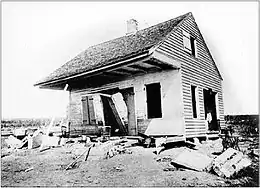1893 Cheniere Caminada hurricane
The Chenière Caminada hurricane, also known as the Great October Storm, was a powerful hurricane that devastated the island of Chenière Caminada, Louisiana in early October 1893. It was one of three deadly hurricanes during the 1893 Atlantic hurricane season; the storm killed an estimated 2,000 people,[1][2] mostly from storm surge.
| Category 4 major hurricane (SSHWS/NWS) | |
 The hurricane wiped the community of Cheniere Caminada off the map, leaving a single, damaged home. Some survivors retreated to what is now Golden Meadow, and others migrated farther inland. | |
| Formed | September 27, 1893 |
|---|---|
| Dissipated | October 5, 1893 |
| Highest winds | 1-minute sustained: 130 mph (215 km/h) |
| Lowest pressure | 948 mbar (hPa); 27.99 inHg |
| Fatalities | 2,000 |
| Damage | $5 million (1893 USD) |
| Areas affected | Yucatán Peninsula, Louisiana, Mississippi |
| Part of the 1893 Atlantic hurricane season | |
Meteorological history

The hurricane was first observed on September 27, 1893, in the northwest Caribbean Sea. Its previous history is unknown; possibly it formed from a trough of low pressure in the area, a similar method of formation for two other storms in the same season. The storm moved to the northwest, quickly strengthening into a hurricane on September 28. It continued to intensify to 95 mph winds before striking land near Cancún of the Yucatán Peninsula on the 29th.
While crossing the peninsula, the hurricane weakened to 90 mph, but restrengthened over the warm waters of the Gulf of Mexico. A low pressure trough over the northern Gulf of Mexico brought the hurricane northward and northeastward. On October 1, this compact hurricane became a major hurricane, and early the next day, it became a Category 4 as it approached the Louisiana coast.
On the morning of October 2, with a peak of 130 mph winds, the hurricane struck southeast Louisiana near Cheniere Caminada, on the Louisiana mainland just west of Grand Isle. The hurricane continued to the northeast, then weakened while crossing southeast Louisiana. Passing over Gulf of Mexico waters for a few hours, the hurricane struck land again on the night of the October 2, this time in southeast Mississippi. The storm continued to the northeast, weakening to a tropical storm over Alabama, and moved into the Atlantic Ocean on October 4. The storm dissipated on the October 5.
Impact

As a strengthening hurricane in the Gulf of Mexico, the Chenière Caminada Hurricane brought a strong storm surge that flooded much of southeast Louisiana. 779 people died out of the town's 1500 residents from the high winds and flooding from the storm surge. The surge was up to 16 feet, with heavy surf above it. The hurricane caused about 2000 fatalities in total, making it among the deadliest United States hurricanes.
The Gulf States were greatly affected by the hurricane. The orange and rice crop were greatly damaged, and combined with destruction of the wind, the hurricane caused about $5 million in damage (1893 USD, $102.6 million in 2005 USD).
Many vessels known and unknown were sunk in the hurricane throughout coastal Louisiana and Mississippi including[3][4]
- SS Joe Webre (steamship)
- SS Alice McGuigan (schooner): Also listed as Alice McGuigin.
- SS Angeline (schooner)
- SS New Union (schooner)
- SS Rosella Smith (bark)
- SS Young American (lugger)
- SS Annie E. B (bark)
- SS Laura B. (sloop)
- SS Three Brothers (lugger)
- SS Alice (sloop)
- SS Bertha (schooner)
- SS Sunny (lugger)
- SS Premier (schooner)
- SS Centennial (schooner)
- SS Pecourt (schooner)
- SS Rosalie (lugger)
- SS Nikita (Austrian bark)
Name confusion
The storm is named after a Louisiana village that bears the name of a Spanish sugar planter, Francisco Caminada.[5] Some sources give the name of the village as “Caminadaville,” while others misspell the name Chenière Caminada as “Chenier Caminada” or “Chenier Caminanda” (with an extra n). The village and other settlements on the island were nearly all destroyed.
Today the town of Cheniere Caminada is located in Jefferson Parish, Louisiana.
See also
- List of tropical cyclones
- List of Atlantic hurricanes
- 1893 Sea Islands hurricane
References
- Blake, Eric S; Landsea, Christopher W; Gibney, Ethan J; National Climatic Data Center; National Hurricane Center (August 10, 2011). The deadliest, costliest and most intense United States tropical cyclones from 1851 to 2010 (and other frequently requested hurricane facts) (PDF) (NOAA Technical Memorandum NWS NHC-6). National Oceanic and Atmospheric Administration. p. 47. Retrieved August 10, 2011.
- Christine Gibson Archived 2010-12-05 at the Wayback Machine "Our 10 Greatest Natural Disasters," American Heritage, Aug./Sept. 2006.
- Falls, Rose C. (1893). Cheniere Caminada or The Wind Of Death: The Story Of The Storm In Louisiana. New Orleans: Hopkins' Printing Office. Retrieved 2009-07-15.
- Gilbert, Troy (2019). "Taking the Helm: The Black Captains of the Gulf Coast and the Unnamed Hurricane of 1893".
- Chase, John. "Frenchmen, Desire, Good Children: . . . and Other Streets of New Orleans!", Pelican Publishing, October 31, 2001. p195.
Further reading
- Davis, Donald W. (1993). "Cheniere Caminada and the Hurricane of 1893". In Magoon, Orville T.; Wilson, W. Stanley (eds.). Coastal Zone '93: Proceedings of the Eighth Symposium on Coastal and Ocean Management, July 19-23, 1993 New Orleans, Louisiana. New York: ASCE. pp. 2256–2269. ISBN 0-87262-918-X.
- Falls, Rose C. (1893). Cheniere Caminada or The Wind Of Death: The Story Of The Storm In Louisiana. New Orleans: Hopkins' Printing Office. Retrieved 2009-07-15. NOTE: The title is incorrectly indexed in Google Books